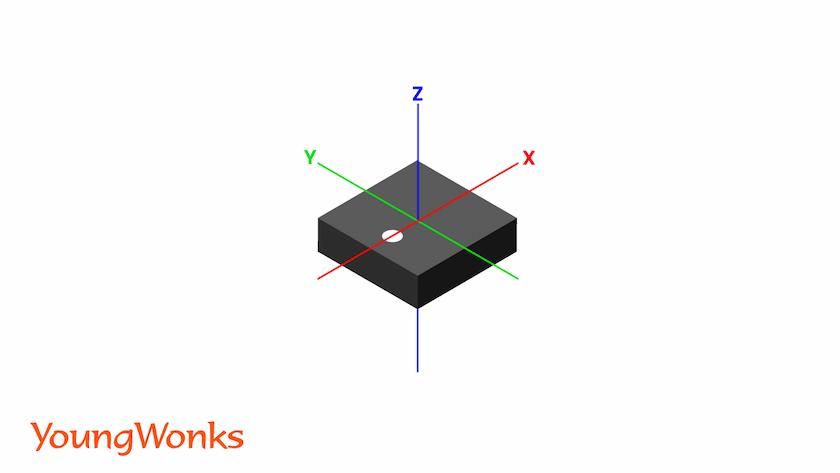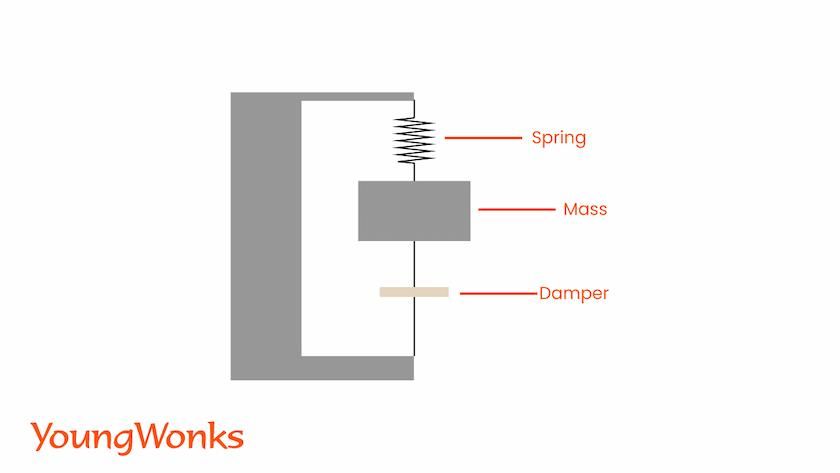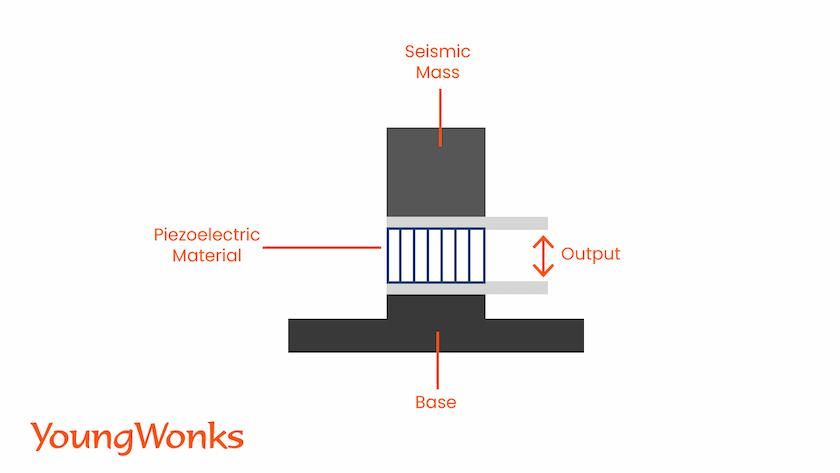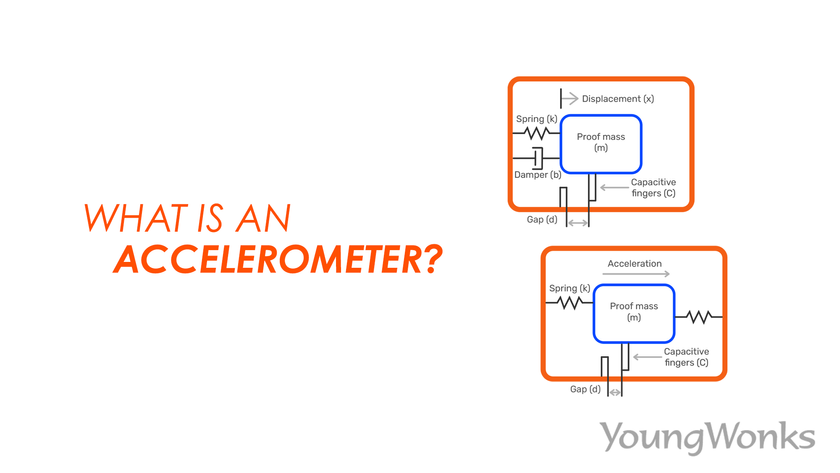Feb 11, 2021 By Team YoungWonks *
What is an accelerometer? What does it do? How does an accelerometer work? This blog shall take a look at all this and more.
What is an accelerometer?
To put it simply, an accelerometer is a tool used to measure acceleration. So what is acceleration? Acceleration refers to the rate of change of the velocity of an object with respect to time.
Newton’s second Law of Motion links force, mass, and acceleration through this very simple equation: Force = mass x acceleration
In other words, acceleration = Force / mass
So acceleration is the amount of force we need to move each unit of mass.
How does an accelerometer work?

Let us take an example to understand this better. We know that acceleration can be arrived at if we know the amount of force and the amount of mass. Now if there’s a car that accelerates from a standstill to a speed (or, rather velocity) of 100km/h in 5 seconds, the acceleration is the change in velocity or speed divided by the time—so 100/5 or 20 km/h per second.
What an accelerometer does then is to help calculate the acceleration. However it is interesting to note that an accelerometer doesn’t measure acceleration by calculating how speed changes over time but by measuring the force. And how does it do that? It basically senses how much a mass presses on something when a force acts upon it.
So for example, if one is sitting in the back seat of a car and the driver accelerates suddenly, you will find yourself thrown ahead and then back into your seat. This happens because the car’s acceleration makes it move forward suddenly. And even though it appears that one is moving backward upon the car accelerating forward, the reality is that the car is trying to move ahead and you in your seat are catching up from the back.
This means that the more the car accelerates, the more force one is going to feel from one’s seat. Thus your brain and body work as an accelerometer: the more force your body experiences, the more acceleration your brain can tell from the difference between the movements of the car and those of one’s body. Accelerometers work in a similar fashion.
At a conceptual level, an accelerometer as a tool is a damped mass, a proof mass, on a spring. When the accelerometer experiences an acceleration, the mass is moved to the point such that the spring pushes (due to the acceleration) the mass at the same speed as the casing. The spring’s compression then indicates the acceleration. The accelerometer being a damped mass, oscillations (wiggles) of the mass and spring do not change the measurements. But the damping also means that accelerometers respond in different ways to different frequencies of acceleration. This in turn is called the frequency response.
Types of accelerometers
There are many types of accelerometers; let us look at them one by one.
Mechanical accelerometer

A mechanical accelerometer is a scaled-down version of passengers sitting in cars shifting back and forth even as forces act on them. Such an accelerometer has a mass attached to a spring suspended inside an outer casing. When it accelerates, the casing moves off right away but the mass stays behind and the spring stretches with a force in tandem with the acceleration. The distance the spring stretches (which is proportional to the stretching force) is used to measure the force and the acceleration in many ways. In fact, seismometers used to measure earthquakes function in this manner; pens on heavy masses are attached to springs so as to register earthquake forces. When an earthquake strikes, it shakes the seismometer cabinet but the pen (attached to a mass) takes longer to move, leaving a jerky trace on a paper chart.
Today, there are many modern takes on the accelerometer; essentially electronic sensors measuring the acceleration forces acting on an object, so as to calculate the object’s position in space and monitor the object’s movement. These accelerometers calculate force by generating electrical or magnetic signals and not by making a pen trace on paper. Take for instance, the piezoresistive accelerometer.
Piezoresistive accelerometer

Here the mass is attached to a potentiometer (variable resistor), like a volume control. The potentiometer turns the electric current up or down as per the size of the force acting on it. Piezoresistive accelerometers increase their resistance in proportion to the amount of pressure applied. Better suited to vehicle crash testing, they are far less sensitive than piezoelectric accelerometers.
Piezoelectric accelerometers

Piezoelectric accelerometers use the piezoelectric effect (piezoelectric materials generate electricity when put under physical stress) to detect change in acceleration. For instance, quartz is a piezoelectric crystal and when it is attached to a mass, the movement of the accelerometer causes the mass to squeeze the crystal, in turn producing a tiny electric voltage. Such accelerometers are usually used in vibration and shock measurement.
Capacitive accelerometers
Capacitive accelerometers are those that use capacitors to measure force. So if a moving mass changes the distance between two metal plates, measuring the change in their capacitance indicates the amount of acting force.
Applications / Uses of accelerometer

Most accelerometers today are miniscule, and thus called Micro-Electro-Mechanical Systems (MEMS) accelerometers. Thanks to their size and affordability, they have become even more popular and are now embedded in a wide array of hand-held electronic devices such as phones, tablets, and video game controllers. In phones and tablets, the accelerometer helps flip the screen when the device is rotated. They are typically used with gyroscopes. While a simple accelerometer consists of a weight that can freely move horizontally, a more complicated design comprises a gyroscope with a weight on one of the axes.
Other uses include in engineering, where accelerometers can be used to measure vibration on cars, machines, buildings, process control systems and safety installations. Accelerometers are commonly used as part of their experiments, especially collision experiments. They can also be used to calculate / monitor seismic activity, inclination, machine vibration, dynamic distance and speed with or without the influence of gravity.
Accelerometers are also used to track the movement of humans (think fitness bands, sports watches and step counters) and by zoologists to track movements of animals in the wild.
Highly sensitive accelerometers are used in inertial navigation systems for aircraft and missiles. In unmanned aerial vehicles, accelerometers help stabilise the flight.
Since they can help measure the motion and vibration of any object/ structure, accelerometers are useful in building and construction work. So they are used to detect changes in driving piles, demolition work, drilling and excavation, moving loads on bridges, impact loads, wind gusts, concussion loads, air blast pressure and avoiding the following: vehicle collisions, falling debris, collapse of structural elements, loss of support because of ground failure.
Today, they also have medical applications: automated external defibrillators today have an accelerometer component which helps measure the depth of CPR chest compressions. This is besides used to measure strike force in physical training.
Other uses include sound recording, where the accelerometer detects changes in the acceleration caused by oscillations in air pressure.
Image stabilization is also where accelerometers are used. Camcorders today use accelerometers for image stabilization, either by digitally moving the image to smooth out detected motion or by moving optical elements so as to adjust the light path to the sensor to cancel out unintended motions. Stills cameras too sometimes use accelerometers for anti-blur capturing. Some digital cameras have accelerometers that help them decide the orientation of the photo being taken and also for rotating the current picture when viewing.
Many laptops have accelerometers built-in, they help detect drops. In such laptops, as soon as a drop is detected, the heads of the hard disk are parked to avoid data loss and possible disk damage.
Exploring the World of Accelerometers Further
For young enthusiasts eager to explore the captivating world of accelerometers and their applications, understanding the principles of coding and electronics is crucial. Engaging in Coding Classes for Kids can lay a solid foundation in software development, while specialized Python Coding Classes for Kids introduce them to one of the most popular programming languages today. Additionally, hands-on experience with hardware programming is made accessible through Raspberry Pi, Arduino, and Game Development Coding Classes, enabling students to create projects that utilize accelerometers in innovative ways.
*Contributors: Written by Vidya Prabhu; Lead image by: Leonel Cruz

